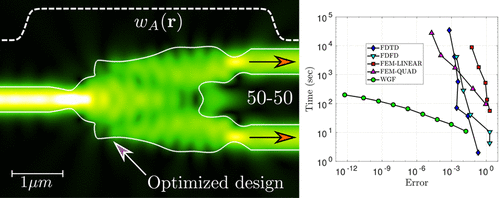当前位置:
X-MOL 学术
›
ACS Photonics
›
论文详情
Our official English website, www.x-mol.net, welcomes your feedback! (Note: you will need to create a separate account there.)
Ultrafast Simulation and Optimization of Nanophotonic Devices with Integral Equation Methods
ACS Photonics ( IF 7 ) Pub Date : 2019-12-04 , DOI: 10.1021/acsphotonics.9b01137 Constantine Sideris 1 , Emmanuel Garza 2 , Oscar P. Bruno 2
ACS Photonics ( IF 7 ) Pub Date : 2019-12-04 , DOI: 10.1021/acsphotonics.9b01137 Constantine Sideris 1 , Emmanuel Garza 2 , Oscar P. Bruno 2
Affiliation

|
Integrated photonics is poised to become a billion-dollar industry due to its vast array of applications. However, designing and modeling photonic devices remains challenging due to the lack of analytical solutions and difficulties with numerical simulation. Recently, inverse design has emerged as a promising approach for designing photonic devices; however, the current implementations require major computational effort due to their use of inefficient electromagnetic solvers based on finite-difference methods. Here we report a new, highly efficient method for simulating devices based on boundary integral equations that is orders of magnitude faster and more accurate than existing solvers, almost achieves spectral convergence, and is free from numerical dispersion. We develop an optimization framework using our solver based on the adjoint method to design new, ready-to-fabricate devices in just minutes on a single-core laptop. As a demonstration, we optimize three different devices: a nonadiabatic waveguide taper, a 1:2 1550 nm power splitter, and a vertical-incidence grating coupler.
中文翻译:

积分方程法快速模拟和优化纳米光子器件
集成光子技术因其广泛的应用领域而有望成为一个十亿美元的产业。然而,由于缺乏解析解决方案和数值模拟的困难,光子器件的设计和建模仍然具有挑战性。最近,逆设计已经成为一种设计光子器件的有前途的方法。但是,由于使用基于有限差分法的低效率电磁求解器,当前的实现需要大量的计算工作。在这里,我们报告了一种新的,高效的基于边界积分方程的设备仿真方法,该方法比现有的求解器更快,更精确,几乎可以实现频谱收敛并且没有数值分散。我们使用基于adjoint方法的求解器开发了一个优化框架,以在单核笔记本电脑上在短短几分钟内设计出新的,可立即制造的设备。作为演示,我们优化了三种不同的设备:非绝热波导锥度,1:2 1550 nm功率分配器和垂直入射光栅耦合器。
更新日期:2019-12-05
中文翻译:

积分方程法快速模拟和优化纳米光子器件
集成光子技术因其广泛的应用领域而有望成为一个十亿美元的产业。然而,由于缺乏解析解决方案和数值模拟的困难,光子器件的设计和建模仍然具有挑战性。最近,逆设计已经成为一种设计光子器件的有前途的方法。但是,由于使用基于有限差分法的低效率电磁求解器,当前的实现需要大量的计算工作。在这里,我们报告了一种新的,高效的基于边界积分方程的设备仿真方法,该方法比现有的求解器更快,更精确,几乎可以实现频谱收敛并且没有数值分散。我们使用基于adjoint方法的求解器开发了一个优化框架,以在单核笔记本电脑上在短短几分钟内设计出新的,可立即制造的设备。作为演示,我们优化了三种不同的设备:非绝热波导锥度,1:2 1550 nm功率分配器和垂直入射光栅耦合器。



























 京公网安备 11010802027423号
京公网安备 11010802027423号